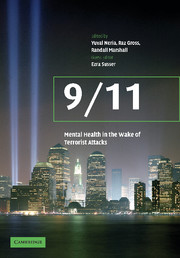Book contents
- Frontmatter
- Contents
- Acknowledgments
- Editors brief bio
- List of contributors
- Foreword
- Part I Introduction
- Part II The psychological aftermath of 9/11
- Part III Reducing the burden: community response and community recovery
- 9 Community and ecological approaches to understanding and alleviating postdisaster distress
- 10 What is collective recovery?
- 11 Rebuilding communities post-disaster in New York
- 12 Journalism and the public during catastrophes
- 13 Effective leadership in extreme crisis
- 14 Guiding community intervention following terrorist attack
- Part IV Outreach and intervention in the wake of terrorist attacks
- Part IV A New York area
- Part IV B Washington, DC
- Part IV C Prolonged-exposure treatment as a core resource for clinicians in the community: dissemination of trauma knowledge post-disaster
- Part V Disasters and mental health: perspectives on response and preparedness
- Index
13 - Effective leadership in extreme crisis
from Part III - Reducing the burden: community response and community recovery
Published online by Cambridge University Press: 27 October 2009
- Frontmatter
- Contents
- Acknowledgments
- Editors brief bio
- List of contributors
- Foreword
- Part I Introduction
- Part II The psychological aftermath of 9/11
- Part III Reducing the burden: community response and community recovery
- 9 Community and ecological approaches to understanding and alleviating postdisaster distress
- 10 What is collective recovery?
- 11 Rebuilding communities post-disaster in New York
- 12 Journalism and the public during catastrophes
- 13 Effective leadership in extreme crisis
- 14 Guiding community intervention following terrorist attack
- Part IV Outreach and intervention in the wake of terrorist attacks
- Part IV A New York area
- Part IV B Washington, DC
- Part IV C Prolonged-exposure treatment as a core resource for clinicians in the community: dissemination of trauma knowledge post-disaster
- Part V Disasters and mental health: perspectives on response and preparedness
- Index
Summary
As he ran, the tears on his cheeks were not from crying. He was too scared to cry. They were from the acrid smoke and ash. There were bodies lying on the street – some were getting help, some were beyond help. People were yelling, “Run, run.” He thought this is what it must have been like in London during the blitz. But he kept running toward the center of trouble. It was his job.
Having traded days off with a friend, David Simms decided to start sunny September 11, 2001, jogging in a park near his home on Long Island. A neighbor stopped him and said, “Aren't you with the New York Fire Department?” to which David nodded. “A plane just hit one of the World Trade Center buildings.” David is a Lieutenant in New York City's Fire Department, Ladder Company 20. So he did what he thought was needed. He drove downtown to his station and found firemen standing around confused. He told them to get their equipment and move out. All of their vehicles were gone so he commandeered a truck to get them as close to Ground Zero as possible. When the truck could no longer get through, they ran.
What he didn't know at the time he was running down the street toward the World Trade Center with his men was that 14 of his comrades were already dead, including the man who had taken his place that day. The next 30 hours were as horrible as can be imagined, but the most challenging aspects of the event were yet to hit David. The nightmares, ever present guilt, flashbacks of shock and deep sorrow plagued him for weeks.
- Type
- Chapter
- Information
- 9/11: Mental Health in the Wake of Terrorist Attacks , pp. 197 - 214Publisher: Cambridge University PressPrint publication year: 2006



